By optimizing its product flow, weigh batching and mix-handling systems, Dawn Food Products Inc. decreased the time and labor needed to handle food mixes while containing dust at its facility in Evesham, U.K.
Dawn is one of the world's largest producers of food bases, mixes, fillings, toppings and flavorings. It uses these components in its privately-labeled cookies, cakes, donuts, muffins and other food products and also sells them to industrial bakeries.
The company originally packaged its mixes in 55-lb bags. By switching to a bulk bag materials handling system, it reduced personnel requirements from seven to four, while speeding production and improving plant safety.
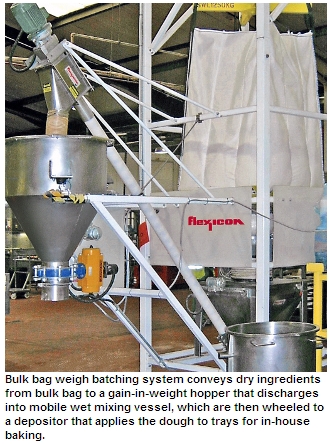
Emptying bags was labor intensive
Dawn's ingredients go through a dry, then a wet mixing process. Originally, after the dry mixing process, operators manually emptied 55-lb bags of dry mix into the wet mixing vessels before final baking. A typical metric ton (1.1 short ton) batch of dry mix filled 40 bags. The bags were sent to three destinations: Evesham's in-house bakery to make baked goods, a sister plant in The Netherlands to make baked goods or to commercial bakeries.
Emptying the 55-lb bags into the 331-lb capacity wet mixing vessels was time consuming and labor intensive. Each bag had to be handled and split separately. In addition, the fine dust created by manually opening and emptying bags was difficult to contain. Furthermore, Evesham's Dutch sister plant preferred to receive mixes in bulk bags.
To overcome these difficulties, Dawn Foods purchased a new bulk solids handling system, including a sanitary stainless steel bulk bag discharger, weigh batching system and flexible screw conveyor, from Flexicon (Europe) Ltd.
Before the system was purchased, Flexicon conducted trials at its test laboratory in Herne Bay, U.K., to evaluate the performance characteristics of muffin powder and chocolate powder mixes, which have bulk densities of 41 lb/cu ft and 35 lb/cu ft, respectively. Both were semi-free-flowing, having angles of repose between 45 degrees and 60 degrees.
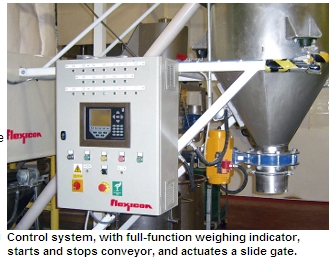
With the new system, a dedicated tote bin is filled from either of two dry mixers and transferred to a loading frame above a bulk bag that will hold one metric ton of product. The tote bin's contents discharge into the bulk bags, which are used internally to feed the wet mixing line or are shipped to Dawn's Netherlands sister plant. Dawn Foods continues to package a portion of its output in 55-lb bags to sell to commercial bakeries.
Filled bulk bags intended for the wet mixing line are transported to a Flexicon Model BFC bulk bag unloader that is equipped with a cantilevered I-beam and electric hoist and trolley that raises and positions the full bag of mix, thus eliminating the need for a forktruck.
The product discharges into a 5.3 cu ft receiving hopper from which a variable-speed rotary air lock feeder meters it into a 10 ft long flexible screw conveyor. The conveyor moves the material to a 5.6 cu ft weigh hopper that feeds the wet mixing vessels. A low-level sensor signals the controller to stop the conveyor when the hopper nears empty.
Batching system controls weight
The system installed at Dawn Foods incorporated Flexicon's bulk-bag loss-of-weight batching system. The bulk bag discharger is mounted on load cells that measure weight loss during the batching cycle and transmit the information to a PLC.
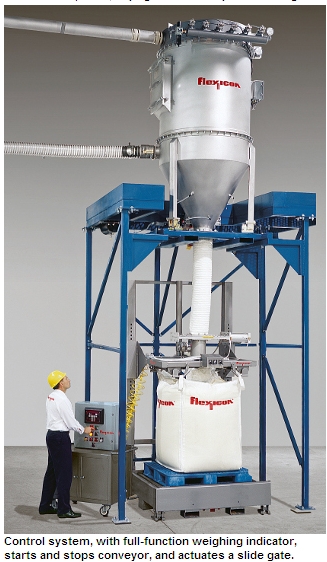
To maximize accuracy, the 10-ft screw conveyor that moves material from the surge hopper to the 5.6 cu ft weigh hopper operates initially at high speed, then at a dribble feed rate and stops when the batch weight has been reached. The controller then actuates an 8-in. pneumatic butterfly valve, and the mixture discharges into one of the wet mixing vessels, which blends it with water.
The controller contains menus for the different products run on the line, and the operator selects the proper one from the menu. Each batch sequence is initiated by a manual start button.
Dust-tight connections
The unloader's bag-to-conveyor interface incorporates a manual Spout-Lock clamp ring positioned atop a pneumatically actuated Tele-Tube telescoping tube. This provides dust-tight connections between the bag spout and the hopper, as well as automatic tensioning of the bag as it empties to promote flow and evacuation.
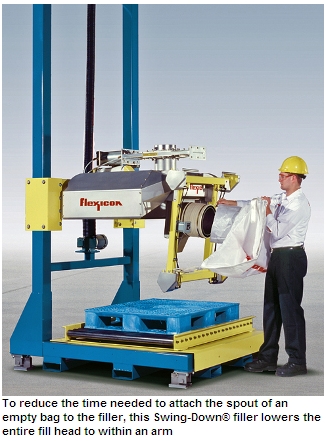
The telescoping tube raises the clamp ring assembly that seals the clean side of the bag spout to the clean side of the telescoping tube, then lowers until the bag spout is pulled taut. Once the spout is untied, the telescoping assembly exerts continual downward tension on the spout, elongating the bag as it empties.
The high-integrity, dust-tight seal between bag spout and clamp ring allows full-open discharge from bag spouts of all popular diameters, eliminating the need for iris valves commonly employed to lessen dust escape.
Dual, pneumatically actuated Flow-Flexer flow-promotion devices raise and lower opposite bottom edges of the bag into a steep V shape to direct material towards the outlet spout and promote total evacuation.
Wet mix makes dough
The wet mix discharges into a depositor that applies the dough to trays for in-house baking. Dawn ships the muffins, chocolate cakes, cookies, and other finished products to such well-known customers as McDonald's and J Sainsbury plc.
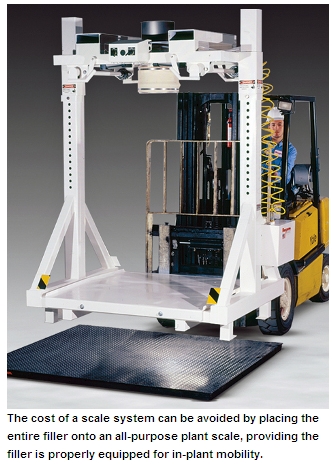
The switch from manual dumping of 55 lb bags to automated handling of the 1-metric ton bulk bags had multiple benefits. It improved speed, efficiency, safety and product quality; reduced the number of workers and eliminated dusting.
SIDEBAR
Six guidelines to specifying a bulk bag filler
David Boger, vp sales and marketing, Flexicon Corp.
With an almost unlimited combination of filler designs, features and upstream equipment from which to choose, specifiers have the ability to tailor bulk bag filling systems according to capacity requirements, expandability, safety concerns, plant hygiene considerations, ancillary filling needs, upstream equipment and sanitary standards. While numerous options can complicate the selection process, they can also yield a highly efficient and cost-effective solution to any given filling problem, providing that fundamental steps are taken to evaluate equipment against precise requirements.
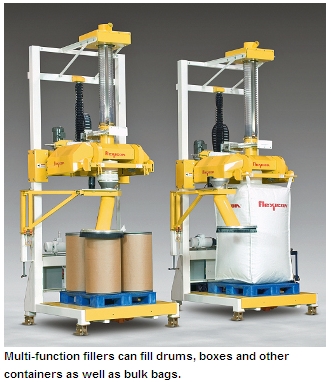
1. Anticipate maximum capacity
With few exceptions, buying a more costly filler with higher capacit than you now need will be less costly than replacing a filler you outgrow, unless that filler can be retrofitted with performance enhancements at a later date.
Generally speaking, the more manual the filling operation, the more output is subject to variation. When gaging the capacity and payback of manual equipment against automated equipment, determine the average pace at which operators can attach, detach and cinch bag spouts, remove filled bags, load pallets and conduct other filler-related operations.
When estimating the time allocated to these manual functions, anticipate a pace that an operator can realistically maintain throughout an entire shift while avoiding fatigue or injury.
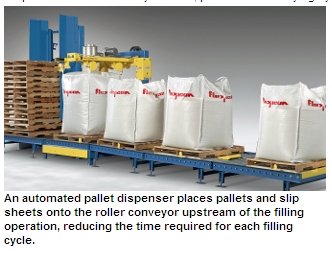
For the lowest volume applications, a basic filler operated manually will maximize your return on investment. One example is a medium-gauge twin-centerpost filler, which offers the structural integrity of four-post fillers but at significantly lower material and fabrication costs and with less weight.
This two-post design also affords unobstructed access to the bag spout and loops, facilitating rapid manual insertion and removal of bags. This class of filler is typically equipped as standard with fill head height adjustment via forktruck to accommodate all popular bag sizes, a feed chute vent port for dust-free air displacement during filling and an inflatable cuff to seal against the bag inlet spout and ensure it does not collapse on itself during filling.
Limited performance options, which can be added initially or retrofitted, include an inflator to expand the bag prior to filling and a programmable scale system with flow control valve for filling by weight.
If a forklift is unavailable to remove filled bags, as is required by the above-mentioned fillers,configurations are available with a three-sided base that provides access from the open side using a pallet jack.This low-profile configuration can also be used to conserve height in low headroom applications.
The time required to prepare empty bags for filling, and to remove filled bags from beneath the filler, can have as much or greater influence on maximum filling capacity than the rate at which material enters the bag.
As such, adding a roller conveyor allows filled bags to be rolled out of the filling area for spout cinching and pallet/bag removal while another bag is being filled. Adding such a conveyor system, however, generally requires a filler with rear posts and a cantilevered fill head equipped with hooks that release bag loops automatically. So if higher capacity is in your future, a rear post configuration may be your best choice today.
Increasing the capacity of systems equipped with roller conveyors to the next level generally entails adding an automated pallet dispenser, which places pallets and slip sheets onto the roller conveyor upstream of the filling operation, further reducing the time required for each filling cycle by limiting manual operations within the filling station exclusively to loading an empty bag.
To further reduce the time needed to attach the spout of an empty bag to the filler, the Swing-Down filler lowers the entire fill head to within an arm's length of an operator standing on the plant floor.
Further, it pivots the bag spout into a vertical position, enabling the operator to connect the spout of an empty bag to the inflatable bag spout collar quickly, after which the spout pivots back to horizontal, the entire fill head returns to fill height, the bag is inflated and filling commences.
Additionally, when the bag reaches its target weight, the bulk material delivery system deactivates automatically, the spout collar deflates, the fill head raises to decouple from the spout and the powered roller conveyor sends the bag downstream of the filling area-automatically, rapidly and safely.
2. Evaluate safety against manual operations
With manual and semi-automated filling operations, theThe cost of a scale system can be avoided by placing the entire filler onto an all-purpose plant scale, providing the filler is properly equipped for in-plant mobility. potential for worker fatigue and injury can increase according to required output per shift, relative to the type of bulk bag equipment specified.
Consider that the connection points of a conventional filler are often beyond the reach of most operators, even when short bags are being filled. But adding the height of a roller conveyor to the height of a bulk bag to the length of its bag loops puts the connection points for bulk bags of only 48 inches in height at approximately seven feet above the floor.
This requires an operator to stand on a platform, a ladder or on the roller conveyor while straining to reach overhead spout connection points and inserting hands between temporarily disabled moving parts. Difficult-to-reach spout connection points can therefore compromise safety as well as capacity-two problems that can be solved with the addition of a fill head that lowers and pivots to the operator at floor level.
Repetitive manual tasks such as releasing bag hooks, placing pallets on a roller conveyor or actuating bulk material delivery, also increase the potential for error and injury, justifying semi- or fully automated equipment for all but the lowest volume applications.
3. Ensure dust is contained
Even the most rudimentary filler is likely to be equipped with an inflatable spout seal to hold the bag spout firmly in place during filling. However, not every fill head is vented to a dust collector to filter displaced air and dust and to vacuum ambient dust in the operator's vicinity during disconnection and cinching. Confirm that the filler you are considering is so equipped, particularly when contamination of the product or plant environment cannot be tolerated.
4. Determine your need for multi-function filling
If your plant fills drums, boxes or other containers as well as bulk bags, multi-function fillers can boost production, undercut the cost of separate equipment and reduce the amount of floor space required. Multi-function fillers can be switched from bulk-bag to drum-filling mode in seconds by positioning the swing-arm-mounted drum-filling chute under the fill head discharge port.
The chute automatically rotates to deliver material to all four drums on a pallet. Similar adapters for boxes, totes or other containers are also available with varying levels of automation.
5. Match the feed source to your material and your filler
Filling capacity, accuracy and efficiency are often limited by the ability of upstream equipment to feed material consistently and in sufficient volumes. High capacity, semi- or fully-automated fillers require high-capacity feeding systems that are typically automated and feed material into the filler by gravity or by a metering device.
The ability to gravity-feed material depends on whether a material storage vessel can be located above the filler and on the material's flow characteristics. The more free-flowing it is, the more accurately its flow can be varied (down to dribble-feed rate) by a valve that must close the instant a precise target weight has entered the bag.
For non-free-flowing materials, a metered feeding system is required to feed the filler accurately and consistently. Metering systems can include a flexible screw conveyor, screw feeder, rigid auger, drag disk, bucket elevator, rotary airlock valve or other device that does not rely on gravity to deliver material to the filler.
The selection of a metering system can hinge on the available space above the filler, since surge hoppers and filter receivers with rotary airlock valves may require more headroom than is available. In these cases the discharge housing of a flexible screw conveyor can often fit between the filler inlet and the ceiling joists, while eliminating the need for a flow-control valve.
For products that are easily aera ted, pneumatic conveying systems should be avoided, since the conveying process can cause the material to require a much lengthier densification/deaeration cycle to achieve the desired fill weight and package stability.
If sufficient headroom exists above the filler, a surge capacity equivalent to the weight of a filled bag can be used to reduce cycle times while maintaining accurate fill weights. This configuration allows bag changeover to occur while the subsequent batch is in the process of being weighed.
When a pneumatic conveyor is used as the material delivery system, the filter receiver can be sized to hold the weight of an entire bulk bag to apply this method.
For the same reason, a surge hopper above the filler can be considered when using mechanical metering devices moving material to the filler from both storage vessels and plant processes.
6. Comply with sanitary requirements
While all fillers can be constructed of stainless steel with ground and polished welds, their designs can preclude sanitizing according to government standards. If your application must meet sanitary requirements, your choices should be limited to designs that are accepted by the USDA Dairy Grading Branch or other agencies to which you must comply, or to which you elect to comply for assurance that sanitary conditions can be maintained.





